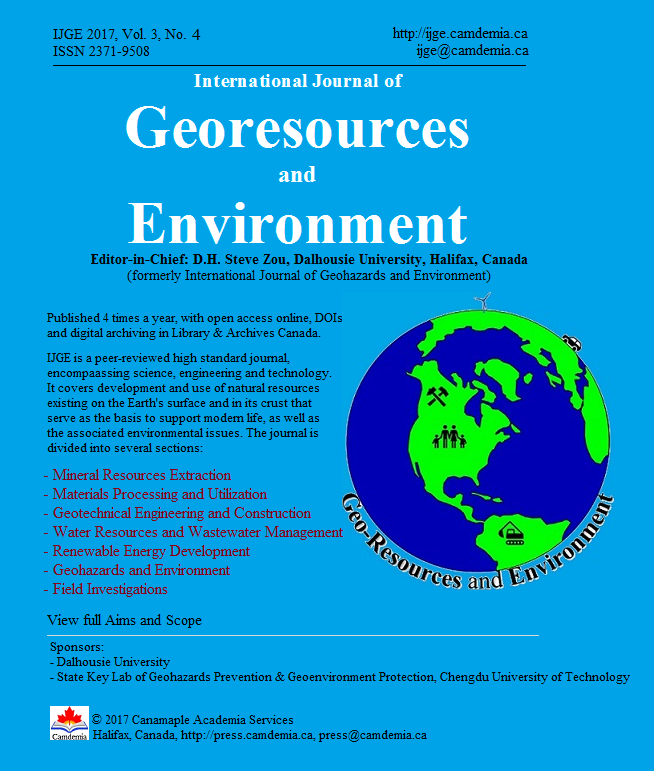An Analysis of Water Management Practices in Uranium Mines in Namibia
DOI:
https://doi.org/10.15273/ijge.2017.04.011Keywords:
cleaner production, environmentally sensitive, freshwater, stakeholder engagement, water stewardshipAbstract
Namibia is a water stressed country with a limited amount of fresh water. Therefore, the use of water is an important topic in the country‘s development agenda. Water is a shared and finite resource, with high social, cultural, environmental and economic values. However, freshwater resources are under pressure from ore processing, industrialization, urbanization and the demands of a growing population. In Namibia, ore processing, coupled with the anticipated increase in water demand for human consumption and other uses, has created significant stress on its limited water resources. This is critical in mining industry as water remains typically the prime environmental medium (besides air) that is affected by mining activities. This study sought to investigate the strides made in water management in mining, especially in environmentally sensitive areas in Namibia. Most mining companies operate adjacent to or alongside farms, national parks and fishing areas. The overall objective of this research is to highlight the current practices in Namibia‘s mineral industry operating in environmentally sensitive areas, especially where uranium is being mined and processed. The methodology consists of comprehensive literature review, field visits to the case study areas, and comparative studies with best practices. This study shows that over a ten-year period, freshwater consumption has been reduced by over 55% per tonne of milled ore in uranium mines, resulting in substantive financial savings as well as a delay in water augmentation through desalination. The strategies employed by Namibian companies involve inclusive stakeholders‘ engagement, recycling and reuse, and the minimization of water losses. The realization that the water challenge cannot be solved by any one party acting alone has been fundamental in ensuring environmental compliance within the mining industry in Namibia. Namibia‘s industrial leaders have increasingly recognized that reducing the water footprint of mining activities must be one of the key performance indicators for management.Downloads
Published
Issue
Section
License
Copyright, Terms and Conditions
The International Journal of Geohazards and Environment (the Journal) is published by Canamaple Academia Services (the Publisher) online with open access, under a Creative Commons Attribution-Noncommercial license (CC-BY-NC) (http://creativecommons.org/licenses/by-nc/4.0/). Authors (the Authors) submitting papers (the Work) for publication in the Journal automatically agree to the following terms and conditions.
1. Under the license (CC-BY-NC), Authors give permission for others to share and reuse the Work, as long as the original source and author(s) are properly cited (i.e. a complete bibliographic citation and link to the Journal website) and the material is not used for commercial purposes. Any sharing or reuse must however indicate the original CC-BY-NC license terms of the work.
2. Authors transfer and assign to the Publisher all copyright in and to the Work. However Authors retain all proprietary rights except the copyright, related to the Work and also retain the rights a) to use, reproduce, distribute, and publicly display the Work in any medium in connection with the Authors‘ academic and professional activities, such as teaching, presentations and lectures, b) to create derivative works from the Work and to make full use of the Work in future research and publications, c) to authorize others to make any non-commercial use of the Work, d) to make both the pre-published and final-published versions available online in institutional and/or disciplinary repositories or on their own websites with a citation and link to the original paper published in the Journal.
3. Authors warrant that the Work is their original work, it is not copied from anywhere or anyone else, they are totally responsible for the authenticity, originality, validity and accuracy, and the facts and views are their own, that the Work contains no matter which is defamatory or infringes any literary or proprietary rights, intellectual property rights, or any rights of privacy, and that the Work has not been simultaneously submitted to any other journals or publishers. Authors further agree that their manuscripts whether accepted or rejected will not be returned and the rejected manuscripts will be disposed at the journal editor's discretion.
Disclaimer: The Publisher, the Journal and the editors accept no responsibility for statements or opinions expressed by authors. Use of information and materials in the Journal is the sole responsibility of users.


